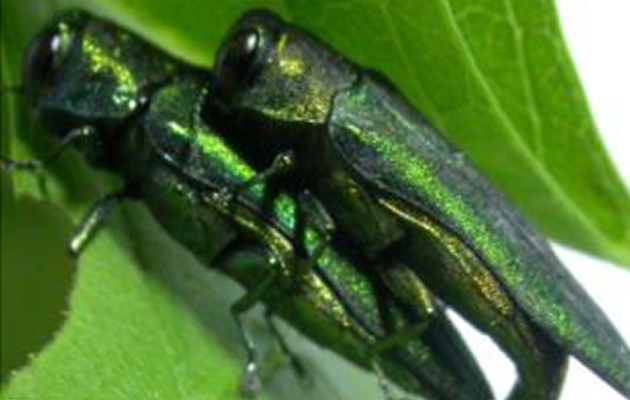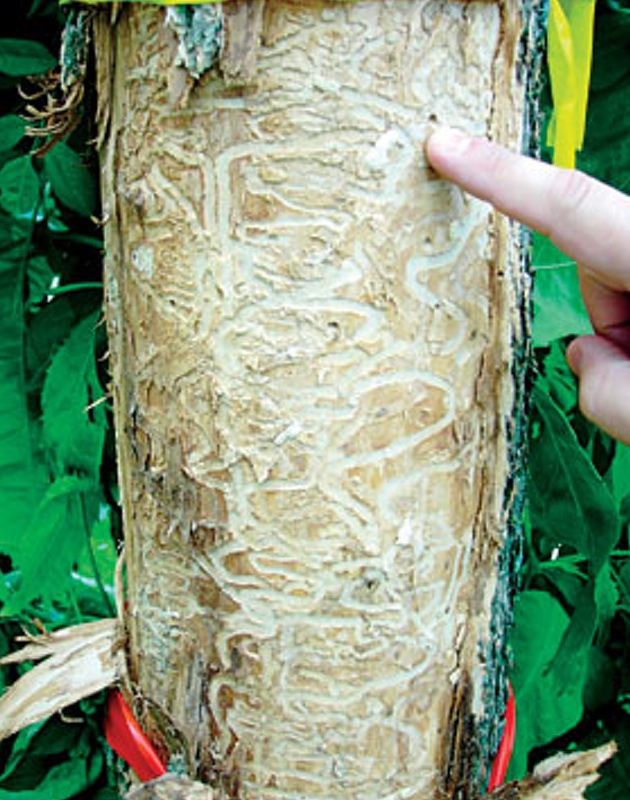An emerald ash borer. Image: Jonathan Lelito/BASF Corporation
Since it was accidentally introduced to North America in 2002, the emerald ash borer has killed about 50 million ash trees across the continent. The invasive beetle originally hails from Asia, but some adventurous individuals managed to stow away in a shipping crate headed for southeastern Michigan, where they began their ecologically devastating rampage.But emerald ash borers have a big surprise coming down the pipeline—femme fatale pest control. Thanks to a new technique pioneered by an interdisciplinary team of researchers, these beetles may soon be brought down by their own libidos.The team created two types of synthetic female ash borers, one with nanoscale-level bioreplication, the other using a 3D printer. The researchers placed the decoys on leaves in Hungarian forests, and wired them up with a 4,000 volt charge. Male beetles eagerly landed on the convincing models, only to get zapped to death. It's a perfect bait-and-switch, and it has the potential to help rescue and from the ravenous beetles. The details of the team's research was published today in the Proceedings of the National Academy of Sciences."Our new decoy and electrocution process may be useful in managing what the US Department of Agriculture Forest Service claims to be the most destructive forest pest ever seen in North America," said co-author Michael Domingue, a postdoctoral fellow in entomology at Penn State, in the university's statement.Indeed, the technique may be applicable to other invasive pests as well. "We have already been working on similar beetles that affect oak trees, that are in the same genus, but include different species," Domingue told me."The techniques seem applicable to all these similar pests, which attack broad-leafed trees or shrubs," he said. "With increasing global trade it is possible that some of these beetles will accidentally be introduced into new areas where they can do a lot of damage, just like the ash borers."In the case of the ash borer decoys, the bioreplicated models ended up having a much higher success rate than the 3D-printed ones. That's not particularly surprising, given the sophisticated method the researchers used to produce them. They sprayed the dead females with nickel vapor, used the hardened nickel coat to create a mold for replicas, then pressed plastic into the mold while applying heat. The decoys ended up being dead ringers to the dead females, right down to the nanoscale.The 3D printed decoys, meanwhile, lacked these intricate surface contours, and male beetles could tell the difference. While the males would often venture a closer look at the rougher, printed models, they didn't land on them.The beetles were discerning in other ways too. Some of the replicas weren't rigged with electricity, and most of the males abandoned those decoys after touching them, indicating that they sensed something was off. But for those decoys that did dole out electric shocks, one touch was all it took to stun and kill the male.
Male beetles eagerly landed on the convincing models, only to get zapped to death. It's a perfect bait-and-switch, and it has the potential to help rescue and from the ravenous beetles. The details of the team's research was published today in the Proceedings of the National Academy of Sciences."Our new decoy and electrocution process may be useful in managing what the US Department of Agriculture Forest Service claims to be the most destructive forest pest ever seen in North America," said co-author Michael Domingue, a postdoctoral fellow in entomology at Penn State, in the university's statement.Indeed, the technique may be applicable to other invasive pests as well. "We have already been working on similar beetles that affect oak trees, that are in the same genus, but include different species," Domingue told me."The techniques seem applicable to all these similar pests, which attack broad-leafed trees or shrubs," he said. "With increasing global trade it is possible that some of these beetles will accidentally be introduced into new areas where they can do a lot of damage, just like the ash borers."In the case of the ash borer decoys, the bioreplicated models ended up having a much higher success rate than the 3D-printed ones. That's not particularly surprising, given the sophisticated method the researchers used to produce them. They sprayed the dead females with nickel vapor, used the hardened nickel coat to create a mold for replicas, then pressed plastic into the mold while applying heat. The decoys ended up being dead ringers to the dead females, right down to the nanoscale.The 3D printed decoys, meanwhile, lacked these intricate surface contours, and male beetles could tell the difference. While the males would often venture a closer look at the rougher, printed models, they didn't land on them.The beetles were discerning in other ways too. Some of the replicas weren't rigged with electricity, and most of the males abandoned those decoys after touching them, indicating that they sensed something was off. But for those decoys that did dole out electric shocks, one touch was all it took to stun and kill the male. But before we can unleash electric ash borer dopplegangers across the continent, a few more hurdles have to be cleared. "For using a new trapping technique at a national level, it has to be tested for efficacy versus other traps, usually by the Animal & Plant Health Inspection Service," Domingue told me."We are not quite at that point with these traps yet, because there are some minor engineering challenges that need to be solved before they realize their full potential," he said. "For example, in the crude traps we built, rain disrupts the electrical supply, rendering them ineffective until the battery can be changed.""In addition, we're planning to develop these into 'remote detection traps' where the event of males landing on the decoys could be reported by wireless technology so that we can know in real time when these beetles are active in an area," he added.Emerald ash borers have let the good times roll during their 12 years in North America. Here's hoping that they get a rude awakening soon, courtesy of some high-voltage honeypots.
But before we can unleash electric ash borer dopplegangers across the continent, a few more hurdles have to be cleared. "For using a new trapping technique at a national level, it has to be tested for efficacy versus other traps, usually by the Animal & Plant Health Inspection Service," Domingue told me."We are not quite at that point with these traps yet, because there are some minor engineering challenges that need to be solved before they realize their full potential," he said. "For example, in the crude traps we built, rain disrupts the electrical supply, rendering them ineffective until the battery can be changed.""In addition, we're planning to develop these into 'remote detection traps' where the event of males landing on the decoys could be reported by wireless technology so that we can know in real time when these beetles are active in an area," he added.Emerald ash borers have let the good times roll during their 12 years in North America. Here's hoping that they get a rude awakening soon, courtesy of some high-voltage honeypots.
Advertisement
Advertisement
